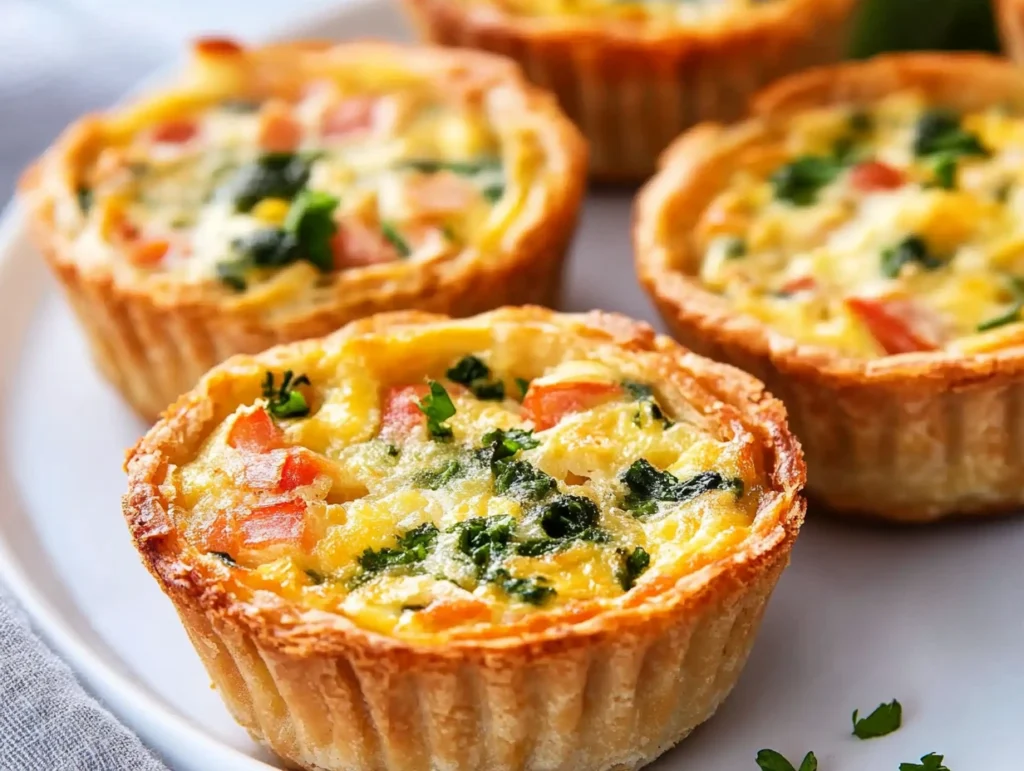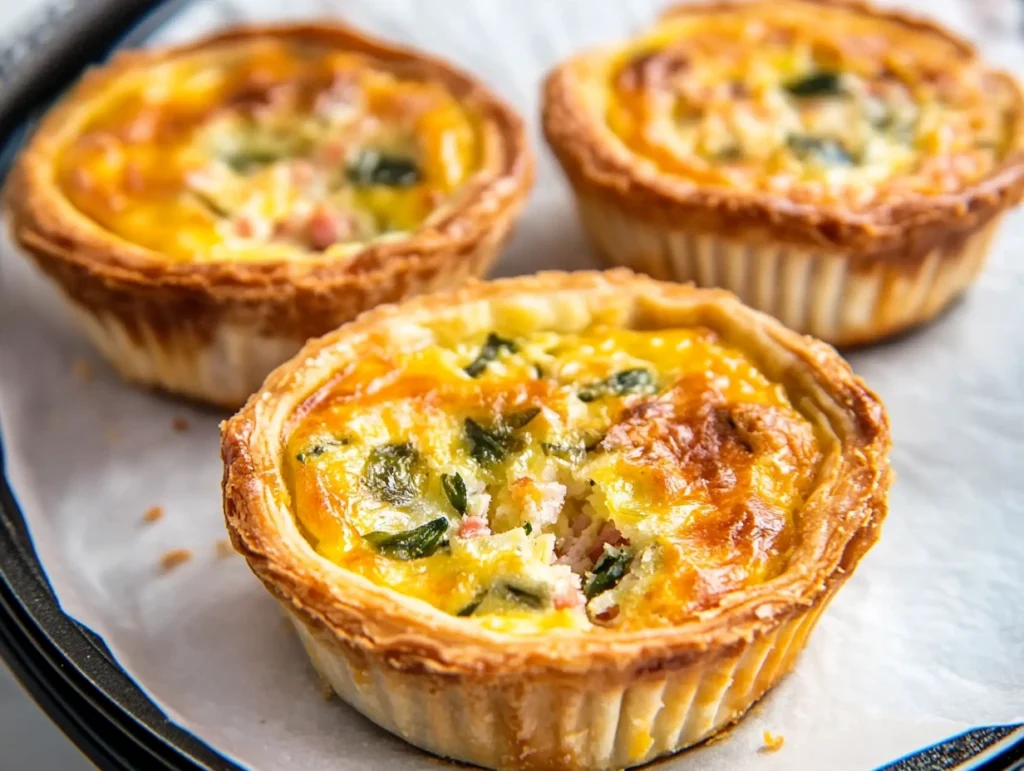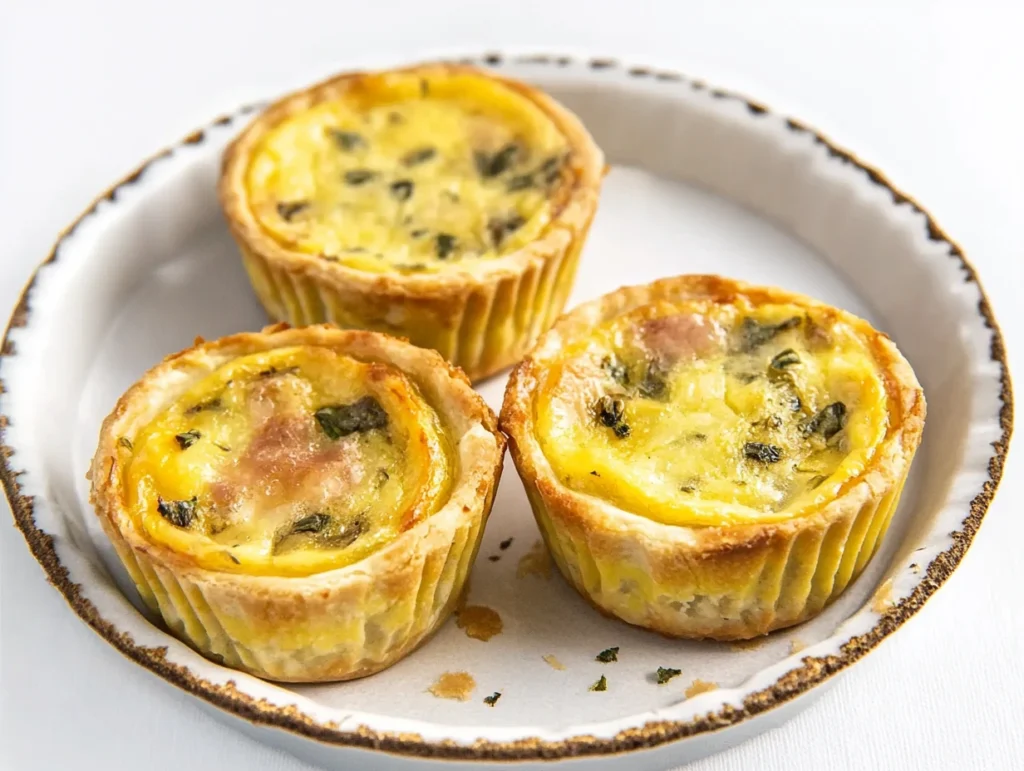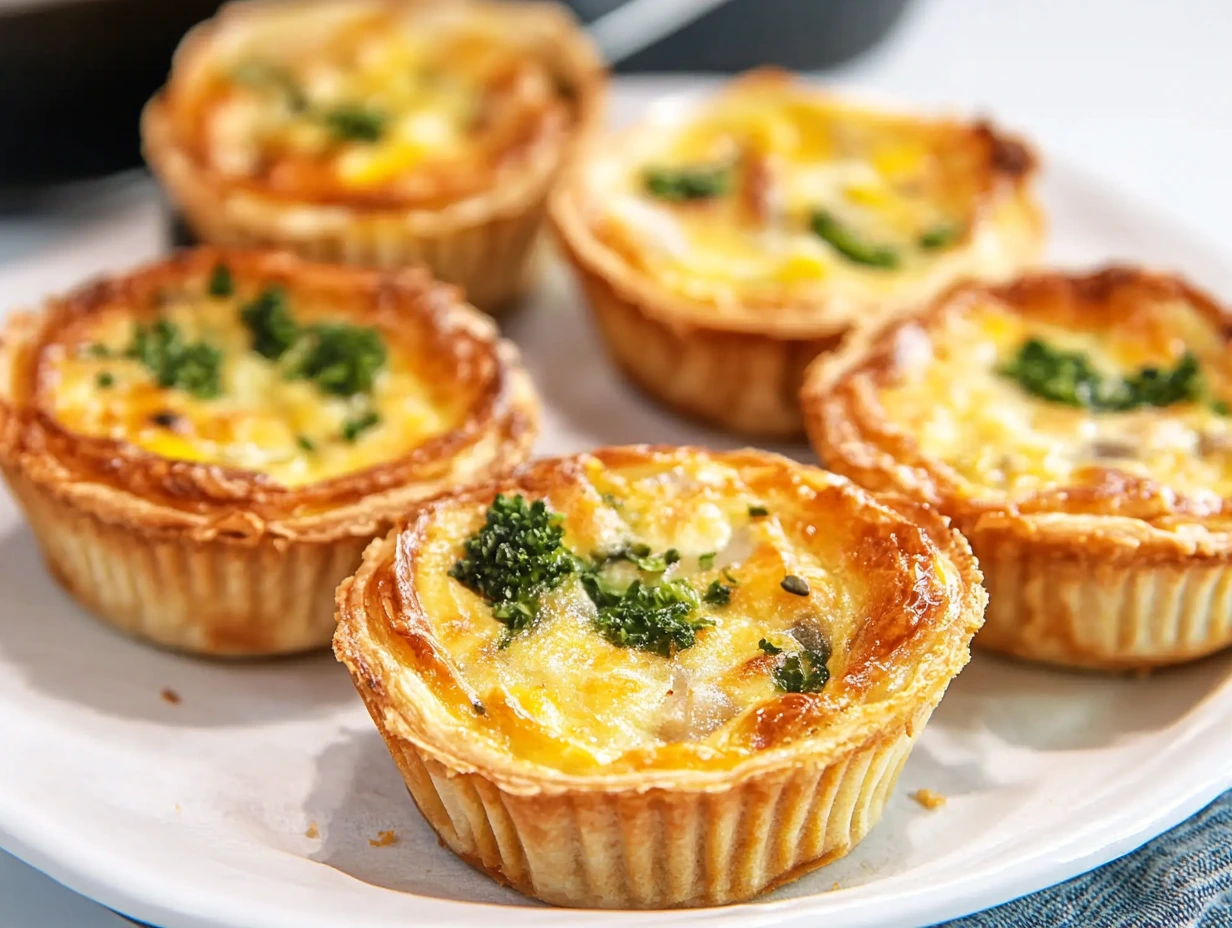Quiche, with its rich custard filling, has long been a favorite at breakfast tables, brunch gatherings, and even as a quick snack. Traditional quiches are made in large pie dishes, but muffin tray recipes are gaining popularity for their convenience and appeal. These mini quiches are perfect for portion control, meal prep, or serving at parties.

What Is a Quiche? A Brief Overview
Quiche is a French-inspired dish that combines eggs, cream, cheese, and various fillings baked inside a pastry crust. It can be filled with an array of ingredients such as:
- Vegetables like spinach, mushrooms, and peppers
- Proteins like bacon, ham, or smoked salmon
- Cheeses ranging from sharp cheddar to creamy goat cheese
Why Use a Muffin Tray for Quiche?
Using a muffin tray to prepare quiche offers several advantages:
- Perfect Portions: Each quiche is individually sized, ensuring uniform servings.
- Convenience: Mini quiches are portable, making them ideal for lunchboxes or picnics.
- Quicker Cooking Time: Smaller portions cook faster than a full-sized quiche, saving time.
- Versatility: Muffin trays allow you to experiment with different flavors in a single batch, catering to diverse preferences.
Benefits of Mini Quiche Muffin Tray Recipes
Mini quiches prepared in a muffin tray aren’t just delicious—they come with a range of practical benefits that make them a favorite for home cooks and busy individuals. Let’s explore how these mini-sized delights can elevate your culinary game.
Portion Control for Balanced Meals
One of the standout benefits of mini quiches is the built-in portion control they offer. Each muffin cup serves as a pre-measured unit, making it easier to manage serving sizes. This is particularly helpful for:
- Calorie-Conscious Diets: By knowing the exact ingredients in each mini quiche, you can monitor calorie and nutrient intake.
- Balanced Nutrition: Customize the fillings to include a mix of proteins, vegetables, and healthy fats for a well-rounded meal.
- Family Meals: Serve just the right amount to each family member without the need to slice and serve a large quiche.
Ideal for Meal Prep and On-the-Go Snacks
Mini quiches are a meal prep dream come true! They’re simple to make in large batches and store well, making them a practical solution for busy weeks. Here’s why they’re ideal for meal prep and on-the-go snacks:
- Make-Ahead Convenience: Prepare a batch over the weekend and store them in the fridge or freezer for quick meals throughout the week.
- Easy Reheating: A quick zap in the microwave or a few minutes in the oven, and they’re ready to enjoy.
- Portable: Perfect for lunchboxes, picnics, or eating on the way to work or school.
- Customizable for Variety: Create multiple flavors in a single batch, so you never get bored of eating the same thing.
Essential Ingredients for Quiche in Muffin Trays
Crafting the perfect mini quiche in a muffin tray starts with selecting the right ingredients. Each component plays a vital role in creating a flavorful, well-balanced dish. Below, we break down the essential ingredients and provide tips for making your mini quiches truly shine.
Choosing the Perfect Crust: Options and Tips
The crust is the foundation of any quiche, providing texture and structure. Here are some crust options to consider:
- Traditional Pastry Crust:
- Use store-bought pie crust for convenience or make your own for a buttery, flaky base.
- Roll out the dough and cut it into circles slightly larger than the muffin cups for a snug fit.
- Phyllo Dough:
- For a lighter, crispier crust, layer phyllo sheets with a brush of melted butter between each layer.
- No-Crust Option:
- For a low-carb or gluten-free version, skip the crust altogether. Grease the muffin tray well to prevent sticking.
- Alternative Crusts:
- Try creative bases like thinly sliced sweet potatoes, zucchini, or hash browns for added flavor and texture.
Tip: Blind-bake the crusts for a few minutes before adding the filling to prevent sogginess.

Must-Have Fillings: Protein, Vegetables, and Cheese
The filling is where you can let your creativity shine. A well-balanced mini quiche includes a mix of proteins, vegetables, and cheese.
- Proteins:
- Cooked bacon, sausage, ham, or shredded chicken add heartiness.
- Vegetarian options like tofu or beans can work well, too.
- Vegetables:
- Popular choices include spinach, mushrooms, bell peppers, onions, and tomatoes.
- Be sure to sauté or roast vegetables first to remove excess moisture and intensify their flavors.
- Cheese:
- Sharp cheddar, mozzarella, Gruyère, feta, or goat cheese can enhance the richness of your quiche.
- Mix and match cheeses for a unique flavor profile.
Tip: Don’t overfill the muffin cups with solid ingredients—leave room for the egg mixture to bind everything together.
The Role of Eggs and Dairy in Quiche Recipes
Eggs and dairy are the heart of any quiche, creating the creamy, custard-like texture.
- Eggs:
- Use fresh eggs for the best results. Typically, a 1:1 ratio of eggs to dairy (e.g., 4 eggs and 1 cup of milk/cream) works well.
- Dairy:
- Heavy cream or half-and-half yields a richer, creamier filling. For a lighter option, use milk or a non-dairy alternative like almond or oat milk.
- Seasoning:
- Don’t forget to season the egg mixture with salt, pepper, and spices like nutmeg or paprika to enhance the overall flavor.
Step-by-Step Guide to Making Quiche in Muffin Trays
Making quiche in muffin trays is a simple and enjoyable process that yields delicious, bite-sized treats. This step-by-step guide will help you prepare mini quiches that are perfectly golden, creamy, and full of flavor. Let’s get started!
Prepping Your Muffin Tray for Success
The first step to making great mini quiches is preparing your muffin tray correctly.
- Grease the Tray:
- Lightly coat each cup with non-stick cooking spray, butter, or oil to prevent sticking.
- If you’re using a crustless recipe, this step is especially important.
- Consider Liners:
- Use parchment paper or silicone muffin liners for easy removal and a professional appearance.
- Liners also help reduce cleanup time.
Tip: A well-prepared tray ensures your quiches release easily and maintain their shape.
Assembling the Crust: Lining the Muffin Cups
The crust is the foundation of your quiche, and proper assembly is crucial for the perfect bite.
- Cut the Dough:
- Roll out your chosen crust (traditional pastry, phyllo dough, or alternative options) and cut circles slightly larger than the muffin cups.
- Use a cookie cutter, glass, or round lid for consistent sizing.
- Fit the Dough:
- Gently press each circle into a muffin cup, ensuring the edges reach slightly above the rim. This prevents overflow.
- Trim excess dough if needed for a neat appearance.
- Blind Bake (Optional):
- Bake the crusts for 5–7 minutes at 375°F (190°C) to prevent sogginess when the filling is added.
Tip: For crustless quiches, skip this step and proceed directly to adding the filling.
Adding the Filling: A Layering Approach
Layering the filling ingredients ensures even distribution and maximum flavor in every bite.
- Add Proteins and Vegetables:
- Divide cooked proteins (like bacon or sausage) and vegetables (like spinach or mushrooms) among the muffin cups.
- Avoid overfilling; aim for the cups to be about halfway full with solid ingredients.
- Sprinkle Cheese:
- Add a small amount of cheese on top of the proteins and vegetables. This helps create a creamy texture and enhances the flavor.
- Pour the Egg Mixture:
- Whisk together eggs, dairy, and seasonings, then pour the mixture into each cup. Fill them almost to the top, leaving a small gap to prevent overflow during baking.
Tip: Use a measuring cup or a small pitcher for precise pouring.

Baking to Perfection: Tips and Tricks
The final step is baking your mini quiches to golden perfection.
- Set the Oven Temperature:
- Preheat your oven to 375°F (190°C) for even cooking.
- Bake Time:
- Place the muffin tray in the center of the oven and bake for 20–25 minutes, or until the tops are set and lightly golden.
- Check for Doneness:
- Insert a toothpick into the center of a quiche. If it comes out clean, they’re ready.
- Cool Before Removing:
- Let the quiches cool in the tray for 5–10 minutes before carefully removing them with a spoon or spatula.
Variations of Muffin Tray Quiche Recipes
One of the best things about quiche is its versatility. Whether you’re catering to dietary preferences or experimenting with new flavors, muffin tray quiches can be easily adapted to suit any taste or need. Here are some creative variations to try.
Vegetarian Quiche Recipes
Vegetarian mini quiches are a delicious way to enjoy vibrant flavors and nutritious ingredients.
- Popular Veggie Combinations:
- Spinach and Feta: Sautéed spinach paired with tangy feta cheese is a classic choice.
- Mushroom and Swiss: Earthy mushrooms combined with creamy Swiss cheese create a hearty, satisfying option.
- Bell Pepper and Cheddar: Bright and colorful, this combination adds sweetness and a sharp, cheesy finish.
- Seasonal Vegetables:
- Incorporate fresh, seasonal vegetables like zucchini, asparagus, or cherry tomatoes for a fresh twist.
- Tips for Perfect Veggie Quiches:
- Always cook vegetables before adding them to the quiche to reduce moisture and intensify flavors.
Vegetarian quiches are a crowd-pleaser, offering a lighter option that’s just as satisfying as their meat-filled counterparts.
Gluten-Free Crust Options
For those avoiding gluten, there are plenty of creative crust alternatives that work beautifully for mini quiches.
- Potato Crust:
- Grated potatoes, pressed into the muffin cups, create a crispy and flavorful base.
- Sweet potatoes offer a slightly sweet and vibrant alternative.
- Rice or Quinoa Crust:
- Cooked rice or quinoa mixed with an egg and pressed into the tray forms a sturdy and gluten-free crust.
- Store-Bought Gluten-Free Dough:
- Many grocery stores now offer pre-made gluten-free pastry dough for convenience.
Low-Carb and Keto-Friendly Alternatives
For those on a low-carb or keto diet, crustless quiches or innovative crust substitutes are excellent options.
- Crustless Quiches:
- Skip the crust entirely and pour the filling directly into the greased muffin cups. The egg mixture firms up beautifully, creating a self-contained quiche.
- Vegetable Crusts:
- Use thinly sliced vegetables like zucchini, eggplant, or portobello mushrooms as a base.
- Press them into the muffin cups and bake briefly before adding the filling.
- Cheese-Based Crusts:
- Create a crust using shredded cheese pressed into the muffin cups. When baked, the cheese crisps up and forms a delicious, crunchy layer.
FAQs About Quiche Recipe Muffin Tray
Here are some common questions and helpful answers to ensure your quiche muffin tray recipes turn out perfectly every time.
Can I Make Mini Quiches Without a Crust?
Yes, you can! Crustless mini quiches are a great option for low-carb or gluten-free diets. Simply grease the muffin tray thoroughly before adding the filling to prevent sticking. The eggs will set and form a self-contained quiche that’s just as delicious.
What Are the Best Fillings for a Muffin Tray Quiche?
The best fillings are a combination of proteins, vegetables, and cheese. Popular options include:
- Proteins: Bacon, ham, sausage, or smoked salmon
- Vegetables: Spinach, mushrooms, bell peppers, and onions
- Cheese: Cheddar, feta, goat cheese, or Swiss
How Do I Keep My Quiche from Sticking to the Tray?
To prevent sticking:
- Grease Thoroughly: Use non-stick spray, butter, or oil to coat each muffin cup.
- Use Liners: Parchment paper or silicone liners make it easier to remove quiches without damage.
- Non-Stick Tray: Invest in a high-quality, non-stick muffin tray for best results.
What’s the Ideal Baking Time for Mini Quiches?
Mini quiches typically bake at 375°F (190°C) for 20–25 minutes. The tops should be set and lightly golden, and a toothpick inserted into the center should come out clean.
Can I Use Silicone Muffin Trays for This Recipe?
Yes, silicone muffin trays work wonderfully for mini quiches. They’re non-stick and make it easy to pop out the quiches without damage. For added stability, place the silicone tray on a baking sheet before filling and baking.
Is Heavy Cream or Milk Better for Quiche?
Heavy cream results in a richer, creamier texture, while milk creates a lighter quiche. For the best balance, use a mix of both. If you prefer a lighter option, you can use low-fat milk or a non-dairy alternative.
Do You Have to Prebake Pastry for Quiche?
Prebaking (or blind-baking) the pastry is recommended, especially for mini quiches. It prevents the crust from becoming soggy and ensures a crisp, flaky texture. Blind bake for 5–7 minutes at 375°F (190°C) before adding the filling.
How Do You Keep a Quiche from Getting Soggy on the Bottom?
To avoid a soggy bottom:
- Blind-Bake the Crust: Prebake the crust to firm it up.
- Cook Fillings Properly: Sauté vegetables to remove excess moisture.
- Use the Right Egg Mixture: Avoid adding too much liquid, and ensure the egg-to-dairy ratio is balanced (typically 1 egg to ¼ cup dairy).
What Is the Filling Formula for Quiche?
The basic formula for quiche filling is 1 egg for every ¼ cup of dairy (milk, cream, or a mix). This ratio ensures a creamy custard that sets properly without becoming too dense or watery.
How Can I Make My Mini Quiches Look More Presentable?
To make your mini quiches visually appealing:
- Garnish: Add a sprinkle of fresh herbs like parsley, chives, or dill after baking.
- Uniform Fillings: Distribute ingredients evenly among the cups for consistent appearance.
- Neat Edges: Trim excess crust before baking for a clean, professional look.
- Use Liners: Decorative parchment or silicone liners can add a polished touch.
Learn how to create a flaky crust with this quiche crust recipe or try a gluten-free twist with quiche dough recipe. For a unique spin, consider trying a tortilla quiche bake recipe, which transforms tortillas into an inventive crust.
Conclusion
Making quiches in a muffin tray is a delightful and practical way to enjoy this versatile dish. Whether you’re looking for a quick breakfast option, a meal prep solution, or a crowd-pleasing snack for gatherings, mini quiches offer endless possibilities. By experimenting with different crusts, fillings, and dietary adaptations, you can customize each batch to suit your preferences and lifestyle.
With the tips and techniques outlined in this guide, you’re ready to create perfectly portioned, delicious mini quiches that will impress your family and friends. So grab your muffin tray, gather your ingredients, and let your creativity shine in the kitchen!

